The Abstract Session (Belgium & Netherlands), 2025: Maybe just a beginning for more sessions…
Interview with artist Micha de Bie, organizer of the second Abstract Session in Delft, October 2025
By Katia Hermann, Berlin
Hello Micha! This project Abstract Session in 2025, first near Brussels, and second in Delft, looks like a bigger project with many post-graffiti artists from all over. How many artists were involved in the first and in the second session?
At the first Abstract Session near Brussels 66 artists came over and made 78 paintings. At the second Session in Delft, 71 paintings were made by 59 artists.
From which countries are those artists?
Talking about the second Abstract Session, the artists came from Indonesia, Spain, Belgium, the Netherlands, England and Germany.
How many female artists came?
In Delft six women participated.
How did you select the artists (apart from the fact of that all were working abstract)?
For the Abstract Session we actually didn’t select the artists. Eyes-B, who organized the first Abstract Session, had a location that would fit quite a large number of artist. He invited friends and known artists, who make abstract art. The artists who could make it on the certain date of the first session, took part of it. There was a chat group on Instagram created, and the artists who were attending were added to this chat group, which was also useful to communicate about the Abstract Session among us. Then for the second Abstract Session, I used the chat group again to invite fellow artists if they would like to paint in Delft. When one of the artists, who were in this chat group, knew another artist painting abstract, this person was also invited and added to the chat group. So the artists were not selected by Eyes-B or me. It was more like if you make abstract art on walls and want to come to the Abstract Session, you just inform Eyes-B and me that you are coming, and we reserved a part of the wall for you.
The first Session was organized by EyesB in Belgium. How did he find this interesting wall that looks like made of puzzle pieces? Where is this wall located, and how big is it?
Eyes-B already knew about this location and another guy from Brussels was responsible, he was already painting at this spot. They talked about this Abstract Session if it could be done at his location. The puzzle pieces that shape the wall are just the existing structure of the concrete blocks which are used to build this viaduct.
The idea was to have a smaller size of the wall to paint, and thus have more time to meet other like-minded artists. You know many via Instagram but not in real life. And if you have a larger area, you will only be busy painting all day. The social aspect is then left behind. The goal was to have more like a defined canvas format on the wall for each artwork. The idea was not to make one big composition like a regular graffiti jam. The idea is also that our Abstract Sessions are not only about painting but more about the social aspect, to become more a community event.
The location is Vogelenzang in Anderlecht (Brussels), next to the Decathlon which is situated over there. I don’t know the exact measurements of the two walls of this viaduct.
Did you paint there yourself?
Yes, I did, and I went there for two days, painting and also socializing with the other artists I knew only via Instagram but never met in real life.
Are the paintings going to stay in Brussels on that wall like a commissioned work?
As far as I know they going to be painted over. I believe it is a hall of fame, but can only be used to make big productions and not just an individual pieces.


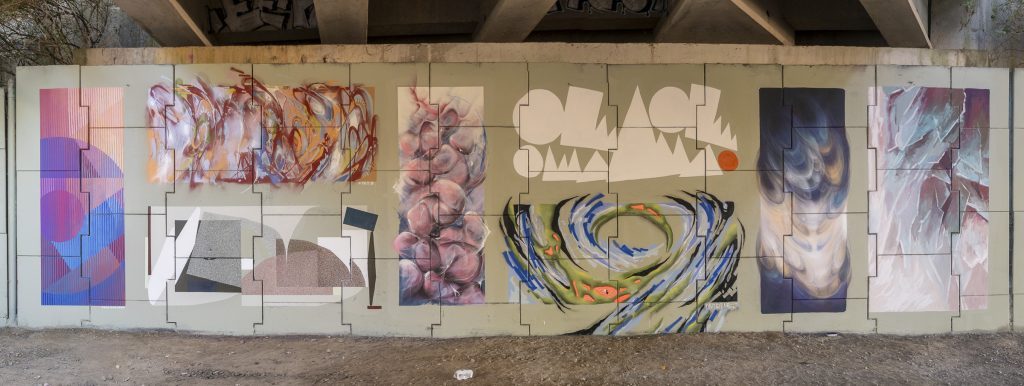
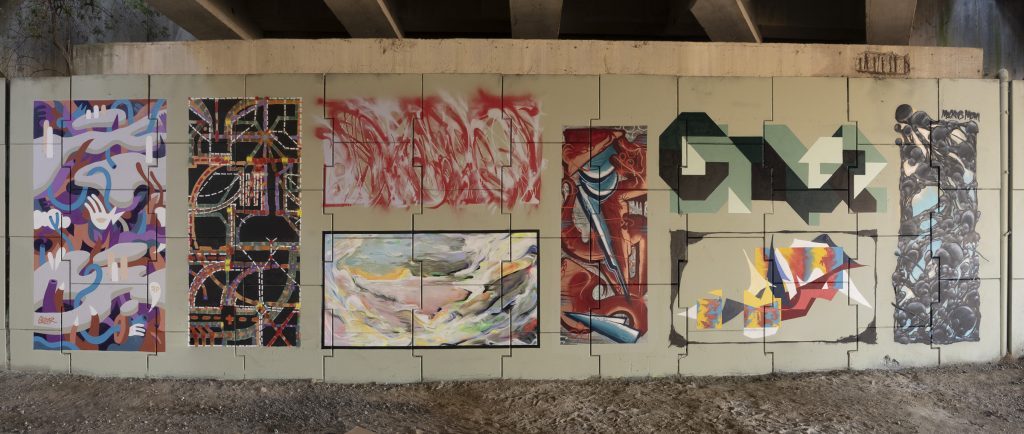
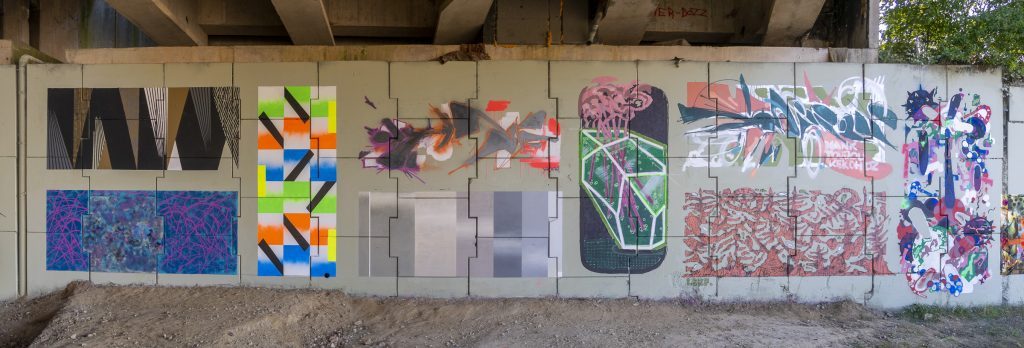

How did you discover the second space, the Kabeldistrict? And for what is it used for today?
The Kabeldistrict is a location which I have been visiting for many years. I live right next to it. Way back in time it was a big, world-famous and known factory for high voltage cables called Nederlandse Kabel Fabriek. After this factory itself became smaller and smaller and left this location, the building was used as a transfer storage for dry food for animals. After this company also left the building it was transformed into a hub for smaller companies, particularly for creative and inventive businesses, a craft brewery and storage spaces. Later on some leisure and sports companies came over. Currently it houses a Padel centre and the Boulder centre, and it is still utilized by these smaller companies.
A friend of mine works at the Kabeldistrict as a Placemaking manager. She sorts out things that can be done for just temporary use. She asked to have a talk about a way of finding signage inside the building so people could navigate to the different companies located inside this building. When we walked through this building we passed by a huge wall (64 meters wide and 12 meters high) and I asked what the plan was with this wall. They actually didn’t have a specific plan for this wall. So I came up with the idea to use it as a curated art wall. They liked this plan. Every half a year, I invite five artists to paint a mural of 10 x 4,5 meters. I curated this wall four times already. To get to this big wall you also pass by other useful walls. Every artist who had painted on the big wall has asked about the other walls. So a couple of months ago, I inquired if I could get these walls as well to paint upon. They asked me to take photos of the walls and sent me back a file with notifications which walls I could paint. Now I have about 400 m2 of walls that I can use.
How big is it and did you have any restraints?
It is a really big building. Some parts are already closed because of the fact that it is not safe to be in these parts of the building. So in the parts of the building we may not paint. One of the restraints I have is that I may not paint on brick walls because they want to keep the authentic look of the building. Another restraint is that it can’t be classic graffiti letters. The last restraint is that it cannot be an artwork containing sexual, political, or religious content.
Are the paintings going to stay permanent at Kabeldistrict?
I see these walls and this location more like a free museum with changing exhibitions. Like the big curated wall, I may only curate it twice a year. The artworks created on these walls are there for six months, and then they will be painted over. The other extra walls I recently get to use and curate as well, I can paint on them whenever I want. But I still leave the painting for a minimum of three months. I may invite people to repaint just one or two and later on again, maybe just some. Doing so, you keep the so-called exhibition vivid and interesting to visit more often.
Was this project funded?
Not at all. The artists paid everything themselves: the paint, the cost of the trip to Delft, the nights at the hotel or Airbnb. We shared paint and tools, carpooled, some slept at my place or at friends home nearby. I had some small scaffolds that could be used, and I could lend a bigger scaffold. I used to prepare the walls beforehand, I already had, and in addition I can get a lot of paint for free due to a deal I’ve made with some local hardware stores.
I did ask the municipality of Delft for a funding. I wrote down the plan I had, and included some pictures and made a cost calculation. I also mentioned that we would pay a part of the costs ourselves. However, in the end, it was a no without any reason. But that didn’t hold us back, and we just went on.
We did receive some support from Padelcity Delft, which is located in the Kabeldistrict and where we also painted some walls inside. They gave us free pizzas and some beers. And the Boulder centre DelftBleau gave us free coffee and tea.

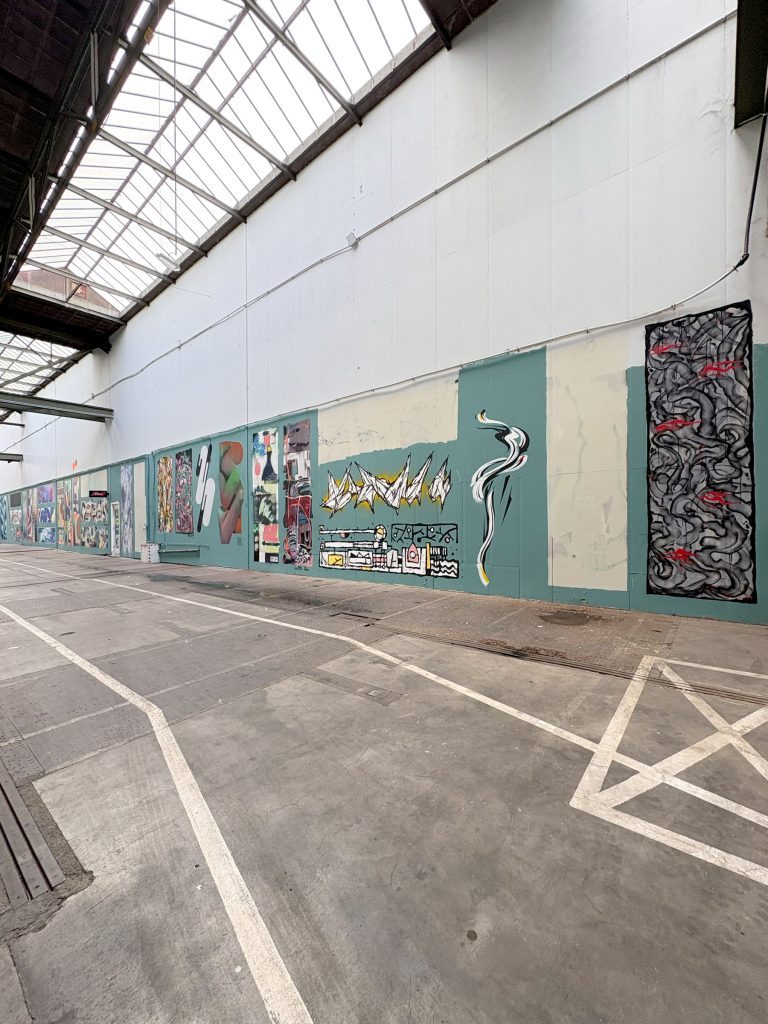
Did the artist have any conditions? Restrictions in size and technique?
No, they didn’t. Just like the first abstract session we checked how many artists would come over and how many square meters we had and then just divided it into a certain amount of square meters per person. So this ended up at both locations around 3,5 to 4,5 m2 per person.
There was no technical restriction. The artists could use whatever they wanted.
What techniques did the artists use?
The techniques were various: spray paint, wall paint, chalk, markers etc. They used rollers, brushes, tape, sponges and all kinds of tools were used.
How much time did every artist have to finalize their works?
Each artist could work in his/her own pace for two days (or more if was needed). Some finished in one day, some in two. Some made two paintings.
Is there the biggest work?
No. The dimensions differ, but eventually the square meters are almost the same. There isn’t one that is way bigger than another one.
How did you define who is painting where? Who will be next to each other?
We leave it up to the artists themselves. It’s like first come, first served. Because of sizes are the same, we didn’t actually care who is painting where. And if you only arrived at the second day, you just painted in the spots that were left over. The only thing is that, because it is an indoor location, some spots are a bit better concerning the daylight. But nowadays with a good camera’s/phone, you can take really good pictures at the end, even if the light isn’t that good.
Who decided about the size and formats, whether horizontal or vertical?
We felt it would be just boring if it were only horizontal or vertical. Since most of us work freestyle, we can adapt to the format. Upfront, with the communication in the chat group, we knew that there were horizontal and vertical formats. But you couldn’t make a reservation. If you wanted to be sure to get of a certain format, you just had to show up early and pick your spot. The early bird catches the worm.
Can you describe the different abstract styles of the works by the artists?
Although all the works are abstract, there are many differences within this ‘style’. Some, for instance myself, work in a geometric mathematical way with straight lines. I have a sketch or a plan in advance. Others work more from their feelings in the space and use an organic way of painting. And some are led by the techniques they use and work from there. They just start and see what happens. This is what we all like about each other. We all have our own way of painting on walls with abstraction, found our own style within abstraction, but we still feel alike.
Is there any artist whose style you appreciate most?
No not really. It is not that I want to be politically correct or want to disgrace someone. I really feel that, all the works that have been created, look very nice and are outstanding, each in their own way. It is not like a competition and I think not so good to compare art. Maybe only if you ask several artists to copy the same image, you can see who made the best copy. But at the abstract session everyone makes their own individual piece of art.


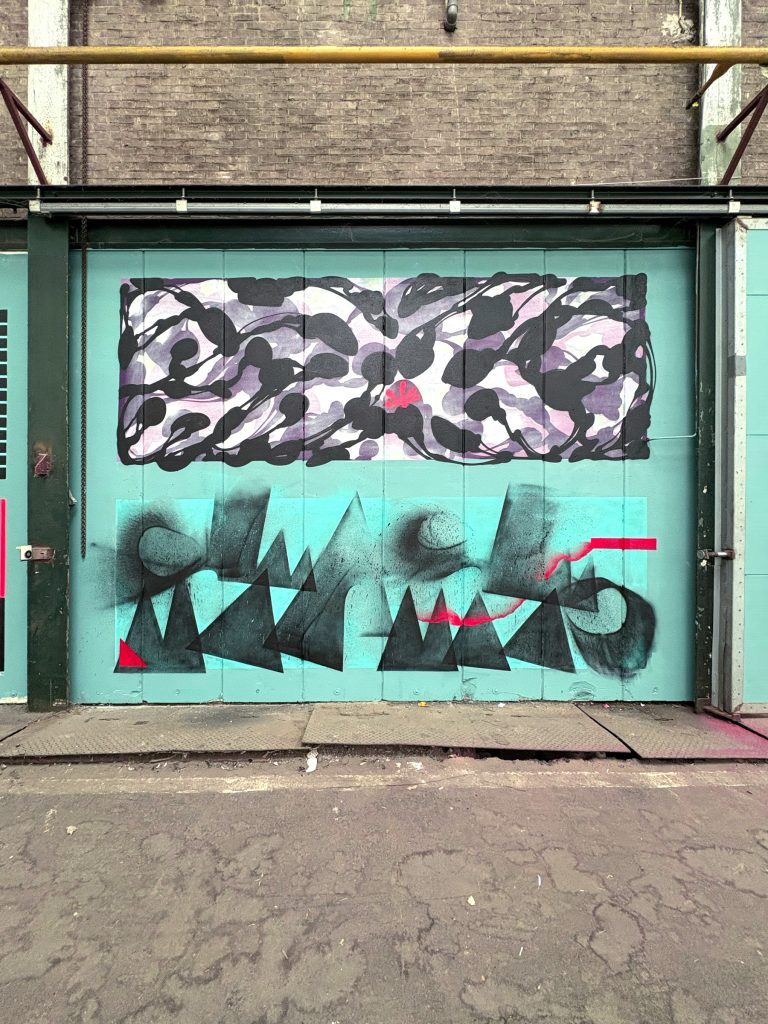
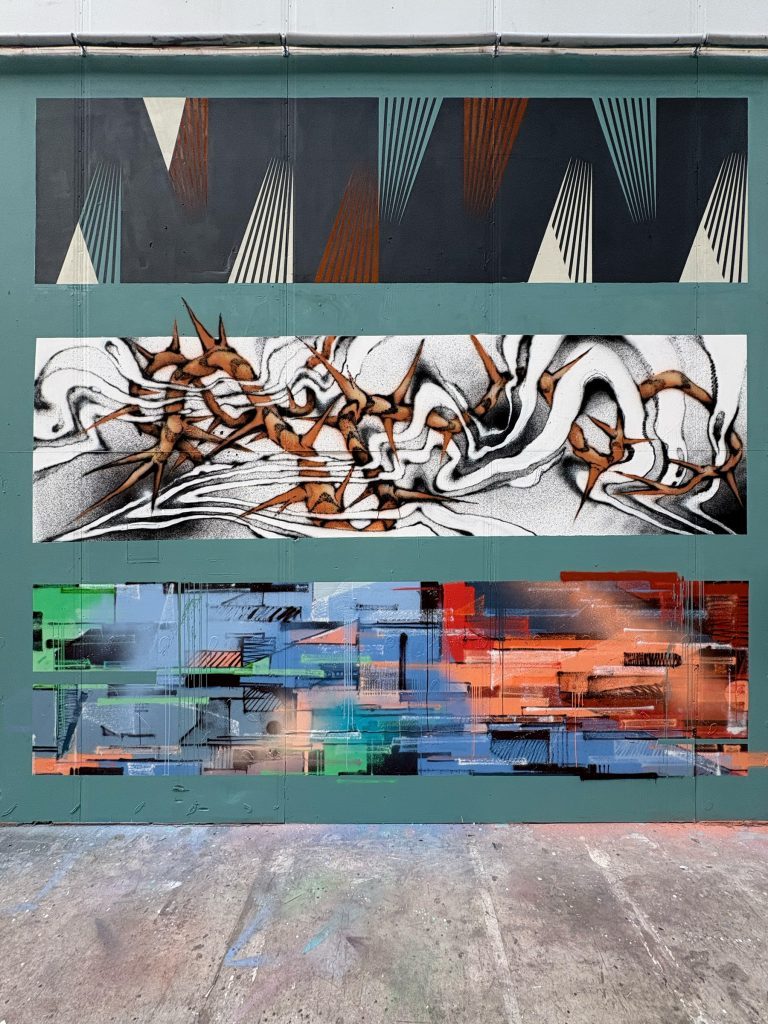
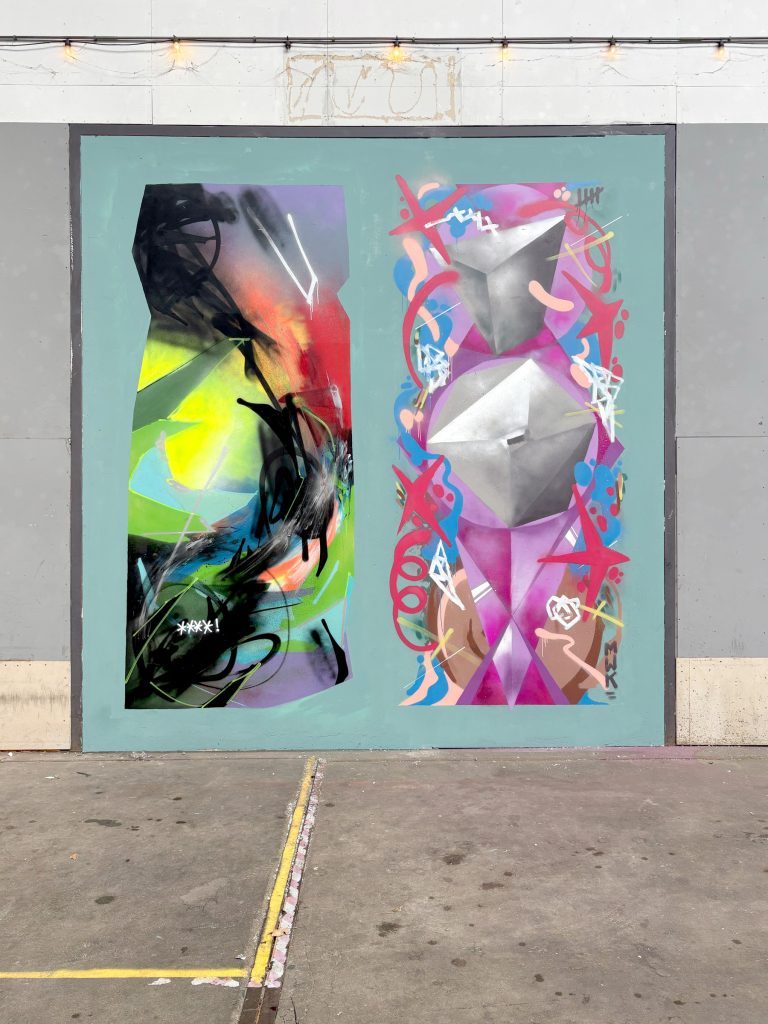
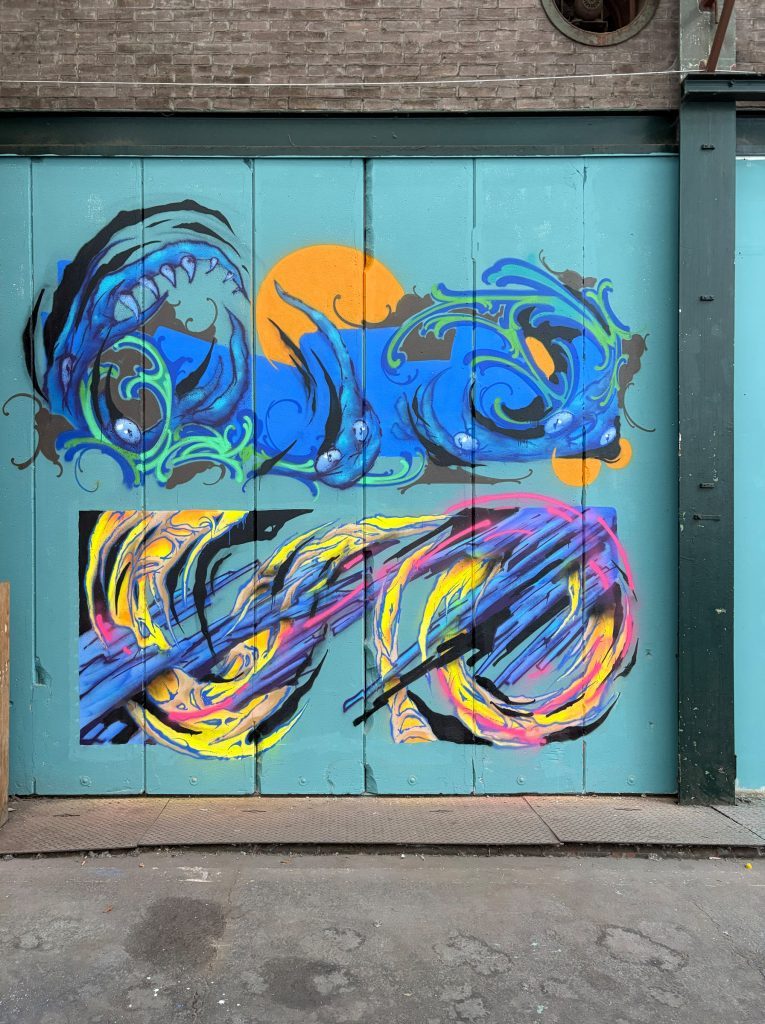
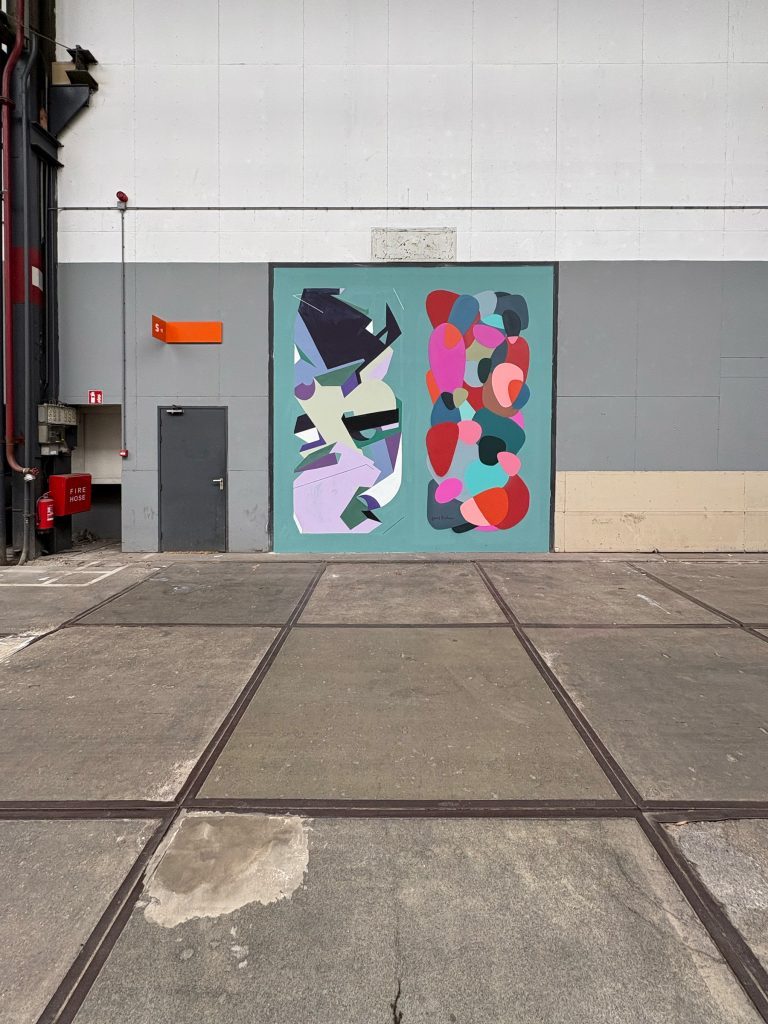
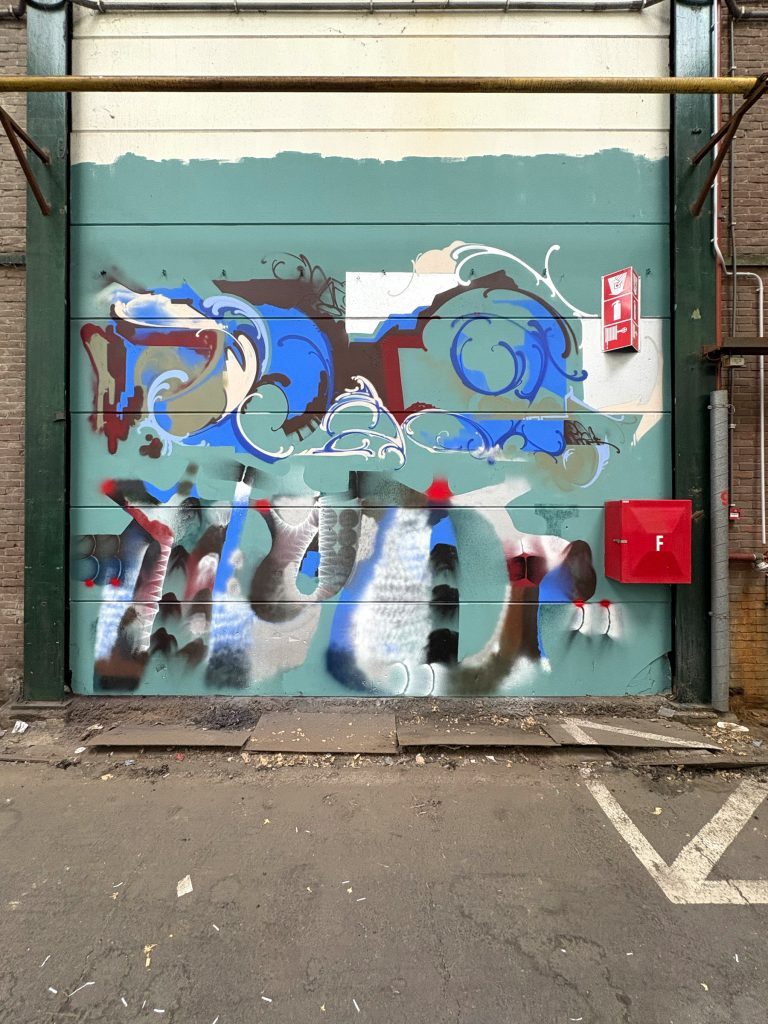

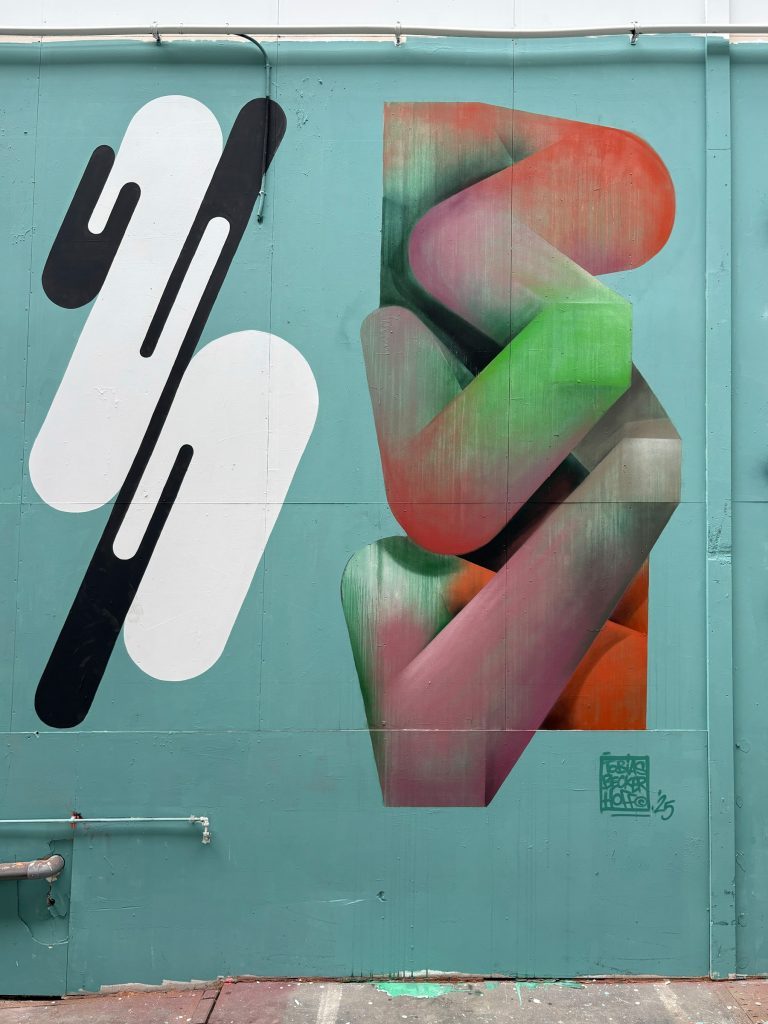
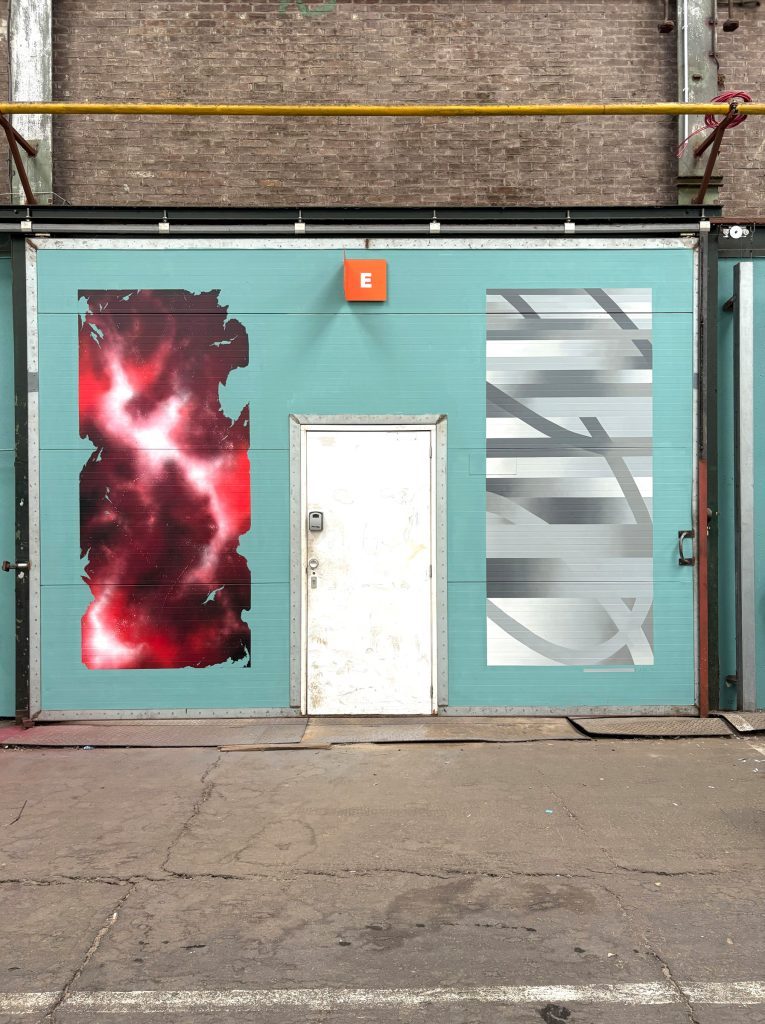
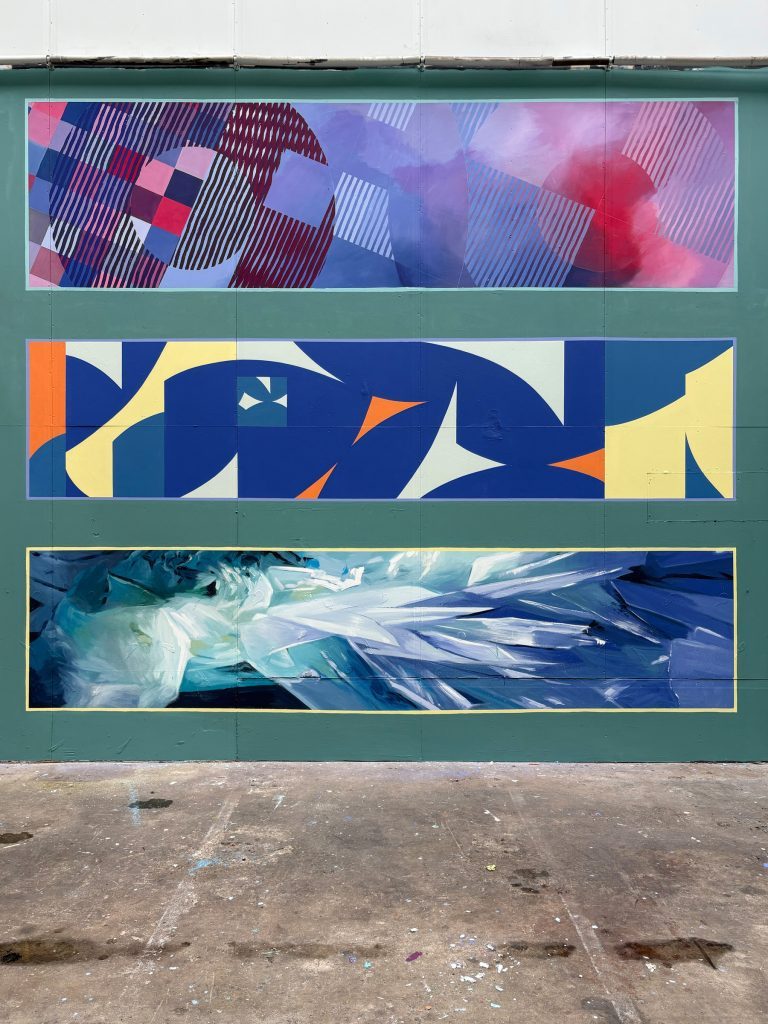
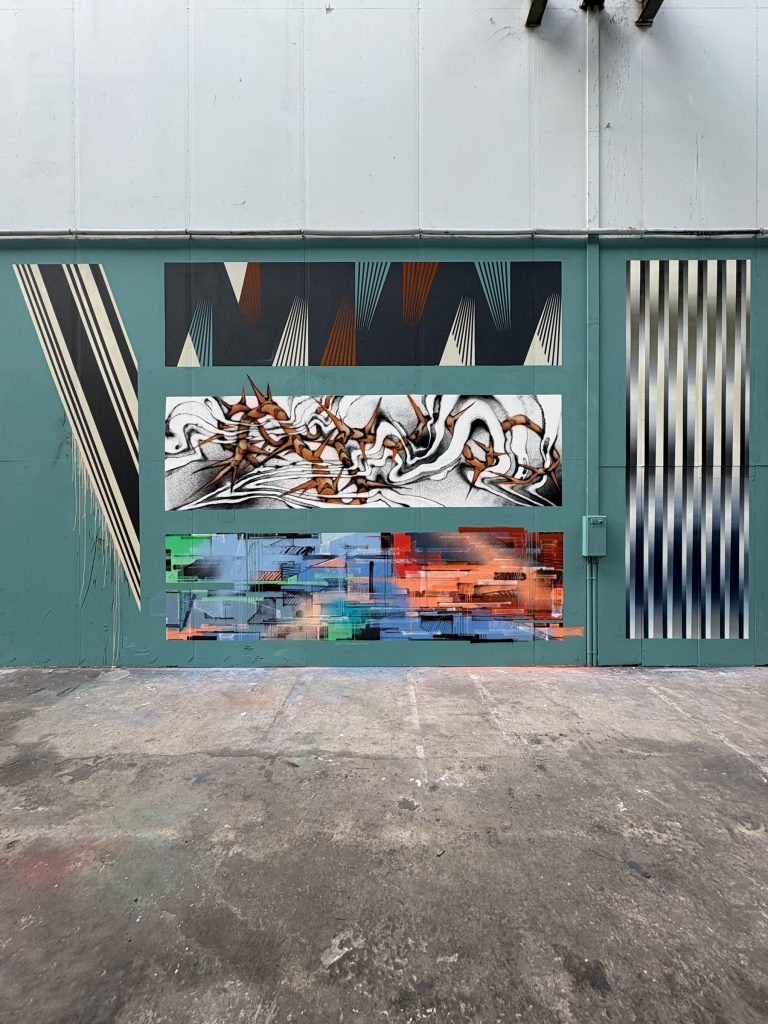

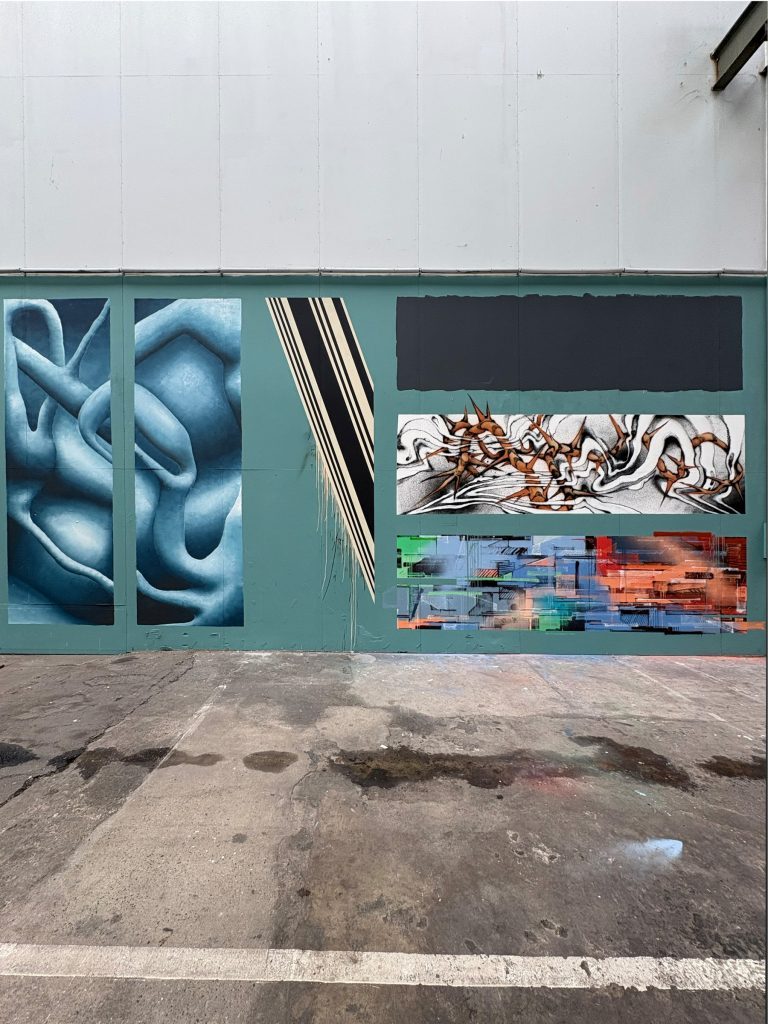
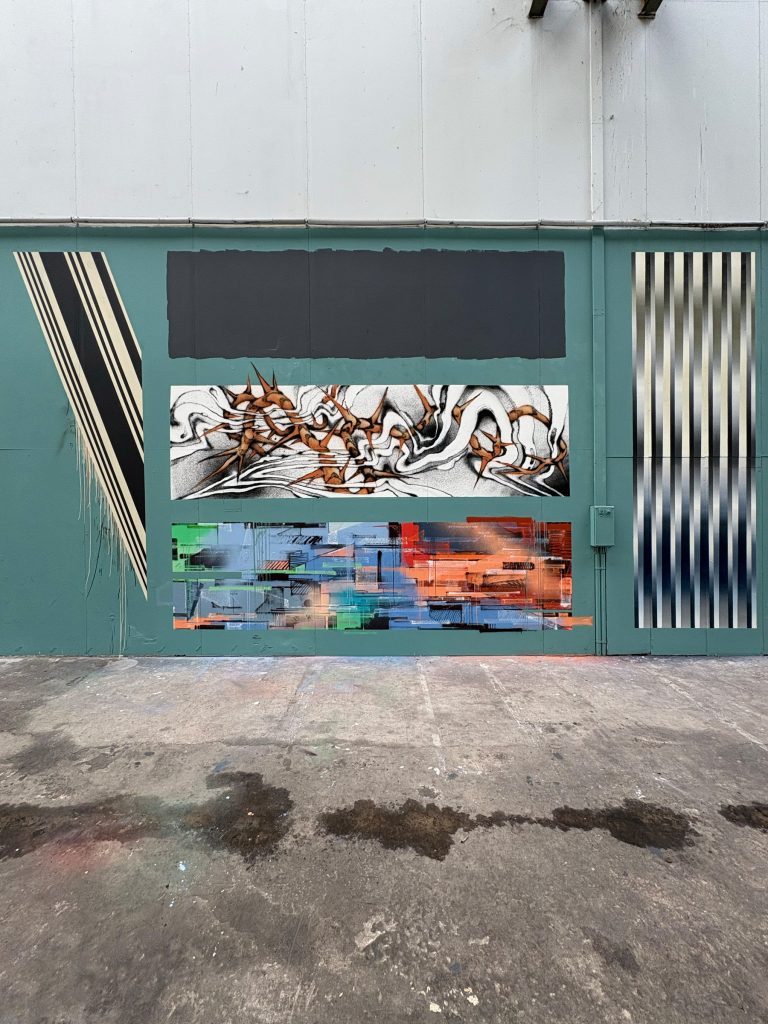
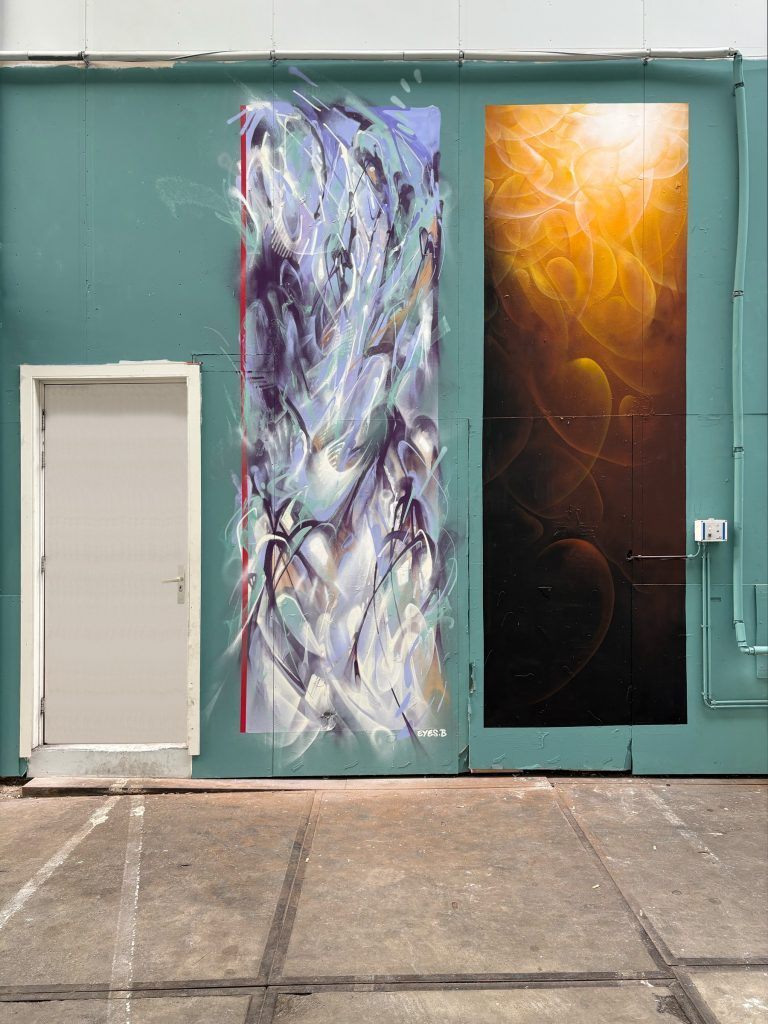
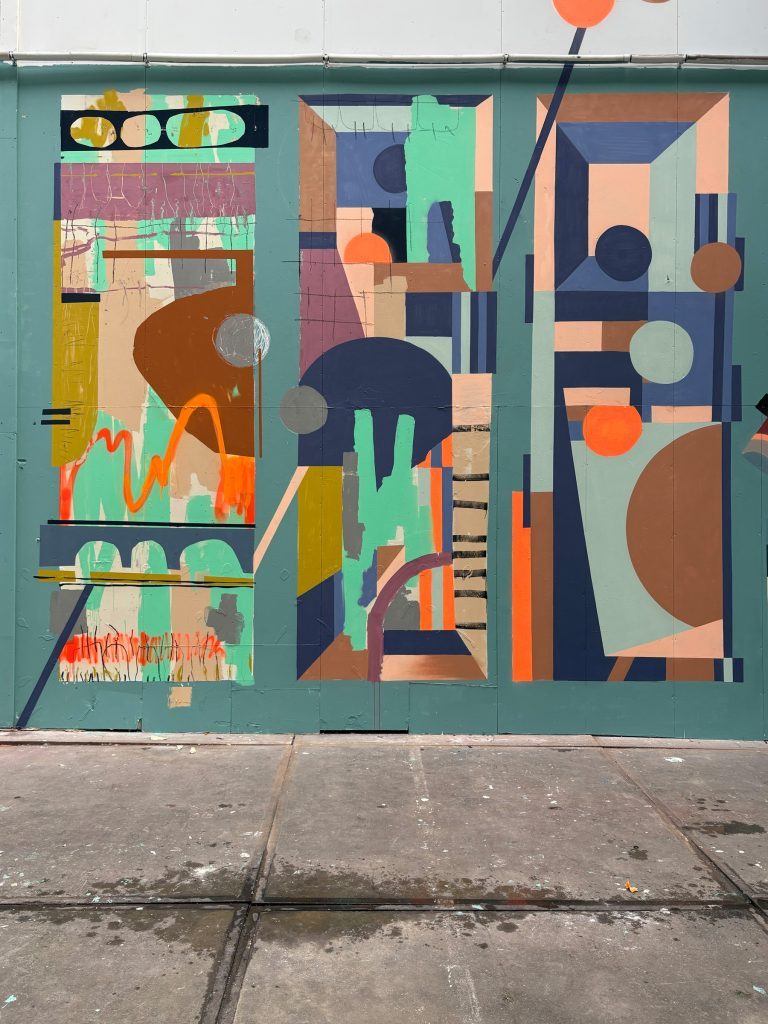
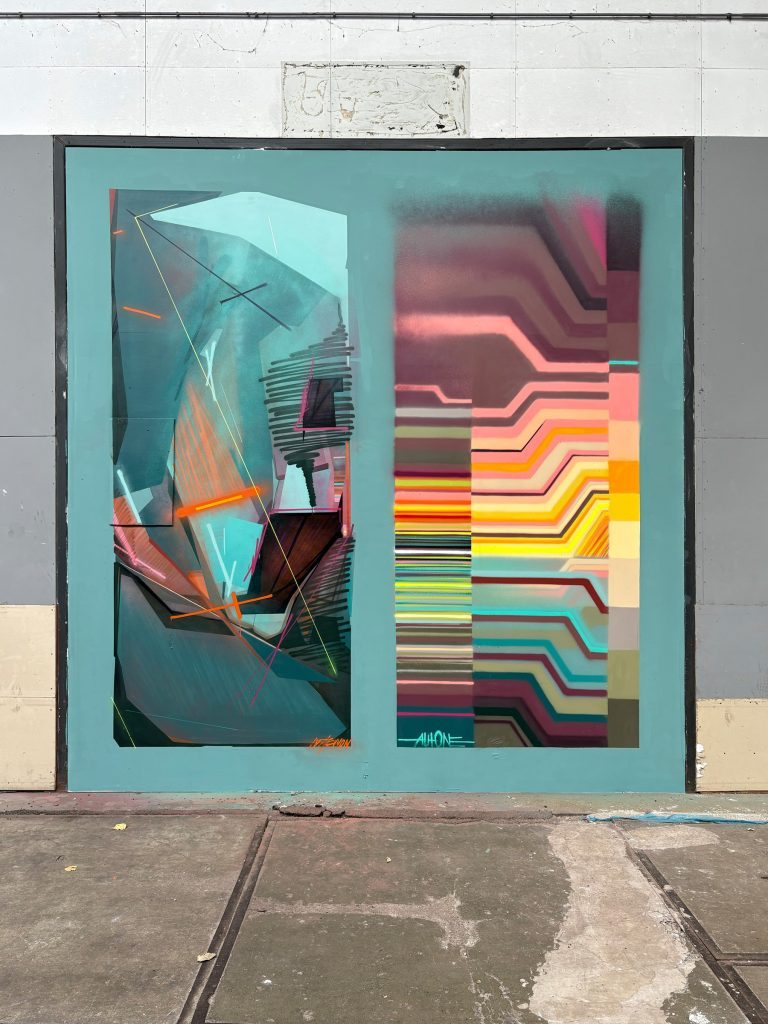
Are there artists you would like to invite for another session ?
It is not like I have just one certain artist that I would like to invite. As long as you are like-minded and make abstract art, you can join.
Did you invite any public or was it not allowed?
We did/didn’t invite public. The location isn’t a closed building, people can visit/enter it the whole day through without any cost or so. It is more like a public street with a roof over it.
But I’m planning along with Kabeldistrict to communicate about those painted walls and the whole location. So residents and visitors of Delft will get to know the location and will visit it more often.
Was it the first collective project you organised?
I like to organise events that are culturally related. Throughout the years and my life, I have organized a lot of things in and around Delft: small festivals, concerts, parties, car shows etc. So, no, this was not the first one.
Are you planning more sessions? A publication of the first two?
We are planning to do more Abstract Sessions, but we don’t have any time span yet when and where. After the first one we had a talk about doing it more often, but also the fact that not only one person should organize it every time. It is time- consuming next to your day job, your life at home with your family etc. So we came up with the idea to try to make it a so-called traveling circus, „a migrating museum“. Visiting the different countries where all the artists are coming from. The artists who can find a location which is suitable for an Abstract Session, and have the time and will to organize it, are free to do so. So who knows where we all are going to paint next. It could be Madrid, London or….
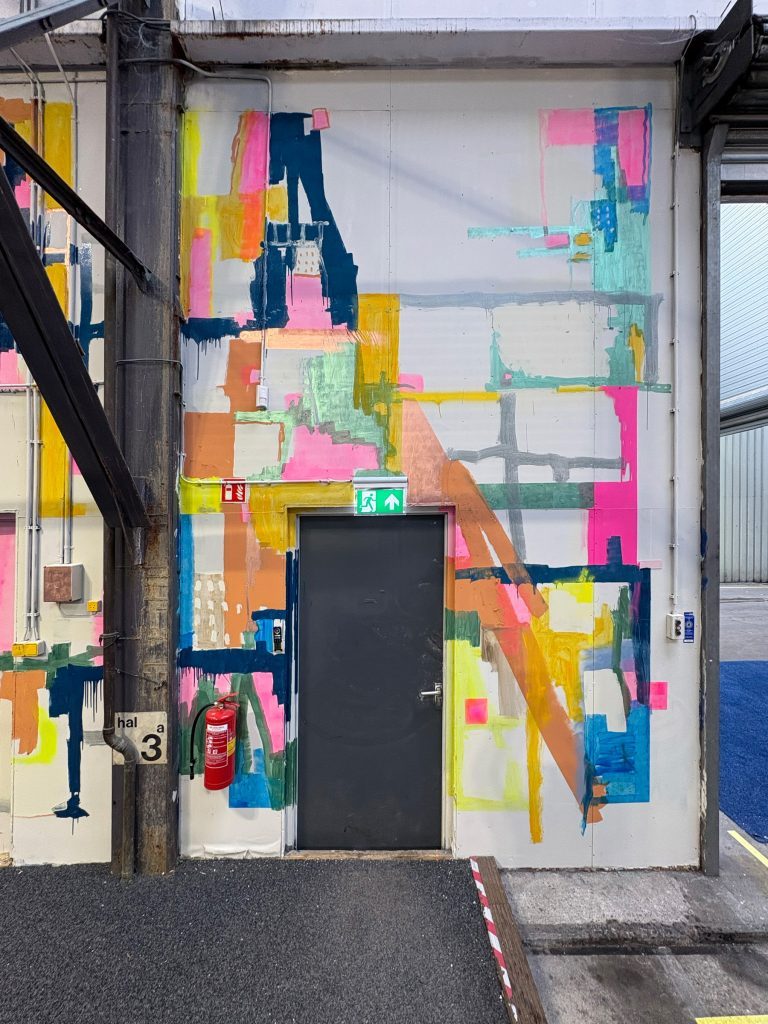

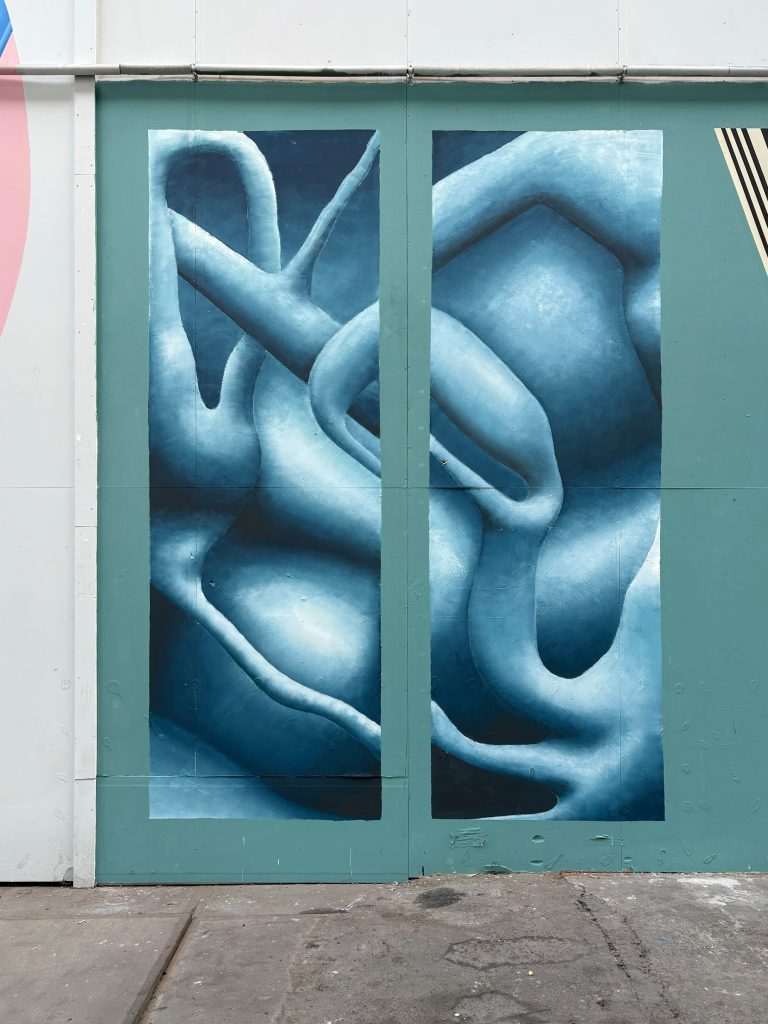

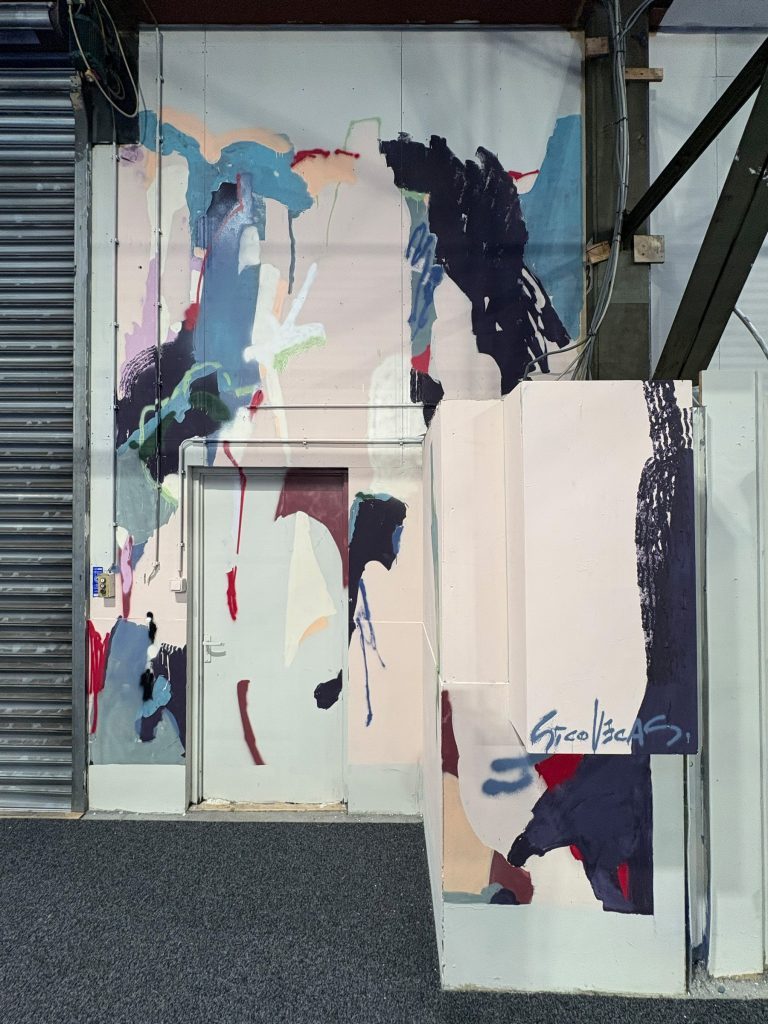

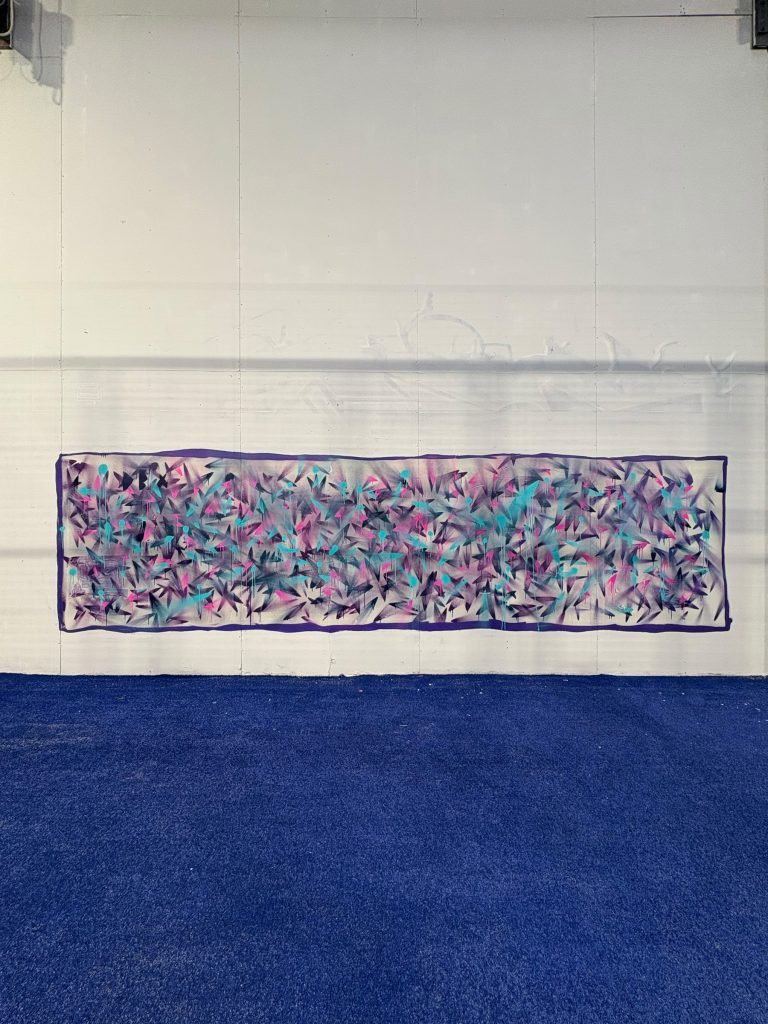

You started yourself with graffiti writing when you were 11 years old, I read. Can you tell us about how you discovered graffiti writing, with what name and style you painted at first, and how active you were in the past?
When graffiti came to the Netherlands in the 80s, I just came across it. In the city of Rotterdam, next to Delft, graffiti was seen on the streets, and also in Delft. And of course also in The Hague and Amsterdam. My parents and I visited these cities often, and we also visited a lot of museums and galleries. My parents also supported me in the way of exploring art. The first piece I made was on our own garden fence we had. Every year, you had to repaint your fence for protection. Then you could choose if you either paint it with wood stain or ask your son: „Go on paint graffiti upon it.“ The day when I was painting there, some older guys (around 15/16 years old) came over and asked if they could also paint on the fence. I said sure, not even knowing who they were. So they came back with spray paint. It turned out that they were graffiti writers from tags and pieces in Delft I had noticed. After that day painting along with them, they asked my parents, because I was only 11 at that time, if I could come over when they had to paint a commissioned wall. So the day when they had to do this job, my dad brought me to that location and I just stayed there the entire day and watched them paint. In some way a very good day, just to watch and learn. From then on I painted more and more graffiti. First using the name Jason, and later in the early 90s with a friend in the crew TSE (The Secret Edition). We sometimes painted in Rotterdam and The Hague and visited Schellingwoudebrug/Flevopark in Amsterdam. Throughout my live, graffiti kept simmering, sometimes more or sometimes less.
Did you study graphic design later?
Yes, I did. At first, I studied at the graphic lyceum in Rotterdam. Worked in graphic arts sector, at a printing company and a design agency. During my time working at the design agency I was studying in the evenings at the art academy of Rotterdam
When did you start working abstract?
I don’t actually know the exact year., but I think around 2009, when I graduated from the art academy.
Are there any visual artists that inspire you?
Too many inspire me, not one certain artist. I can also be inspired by architecture or even shapes of shadows that appear.
How did your own abstract painting evolve over the years?
It just happens I guess. I found a certain way of designing my geometric mathematical style and something to hold on to and work with. And still try to evolve as we speak. There is a base I use as a starting point and from there, I just go on. Sometimes I try something new to add or change it, and then I see if it works out and if it I feels right.
What is important to you for a satisfying composition?
I work very mathematically and start with a grid. I try to start with a certain shape which I then repeat a couple of times within the design/composition I’m making. Just by changing some small parts, it doesn’t become a repetitive pattern, but it still feels alike. Next to that, the placement and the surroundings also make the composition satisfying. For me not only the design makes the composition. I often paint in urban locations, and then I try to match the composition with the place/wall that I find there. But most of the time you don’t know what the surroundings give you. You just bring certain colours along, but you don’t know if it will blend in or match with the surroundings or just with a small detail in the surroundings. For me, it is satisfying if all comes together like a puzzle. The design can be placed really well in the surroundings, the colours match with the environment and the natural light that is at the location. The complete image altogether, makes it satisfying to me.
Do you have any future projects you want to talk about?
For now, I’m curious where and what these Abstract Sessions will bring us to, and how it will bring international artists closer to each other – not only as Instagram friends, but to get to know each other in real life, and meet more often in the future.


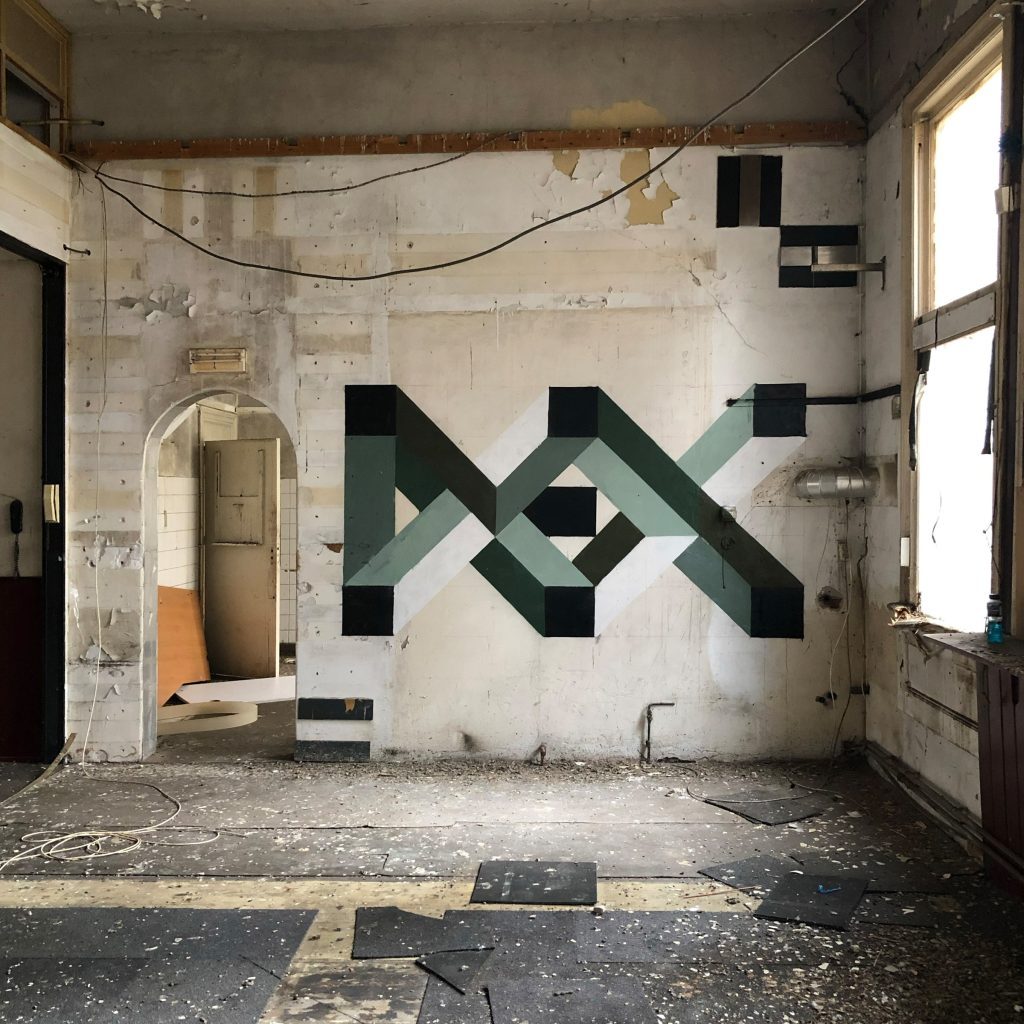

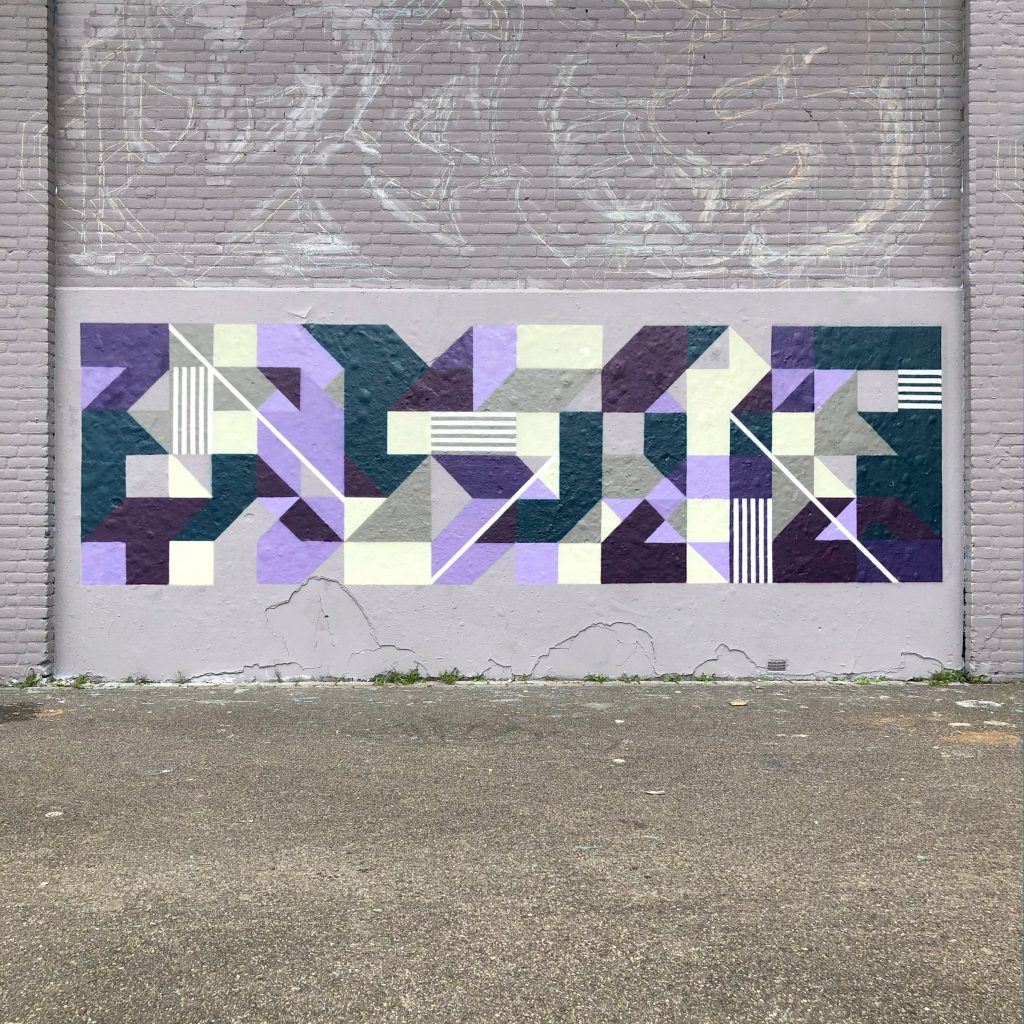

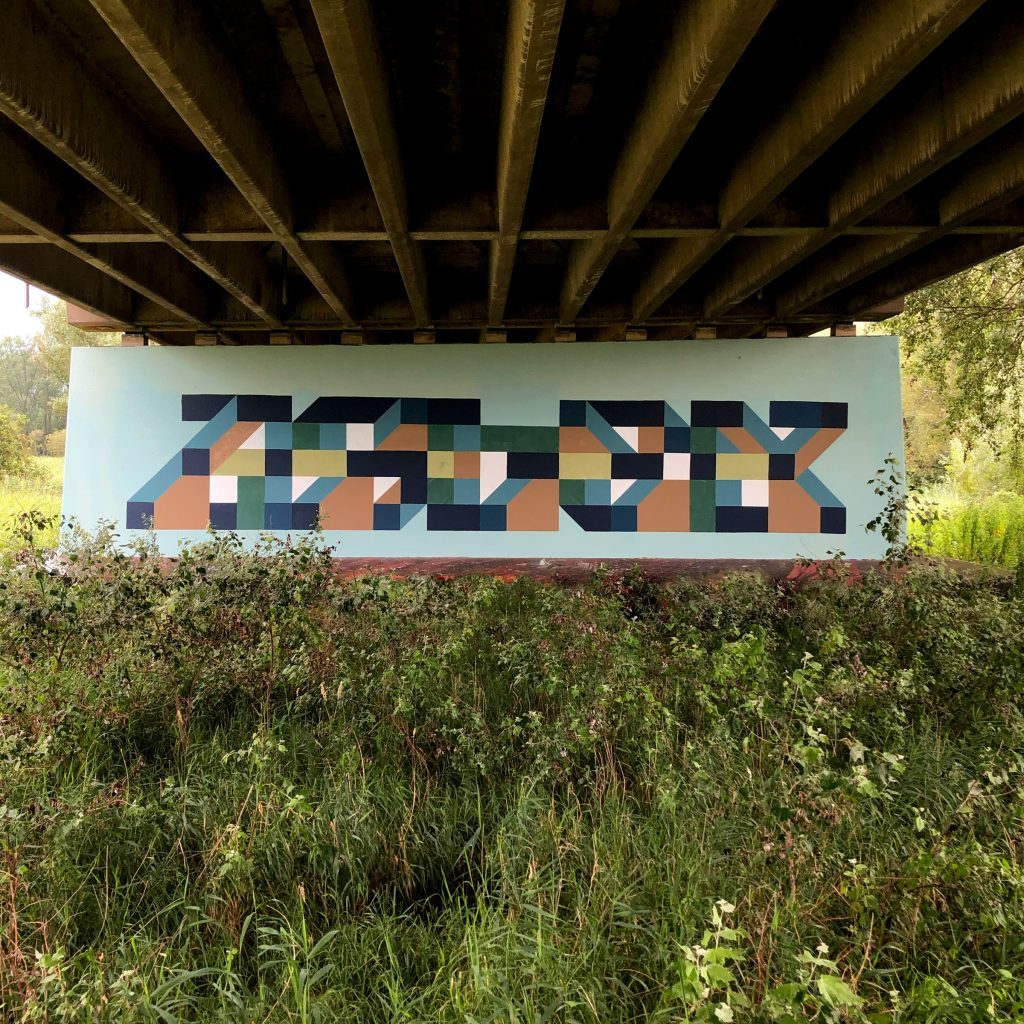


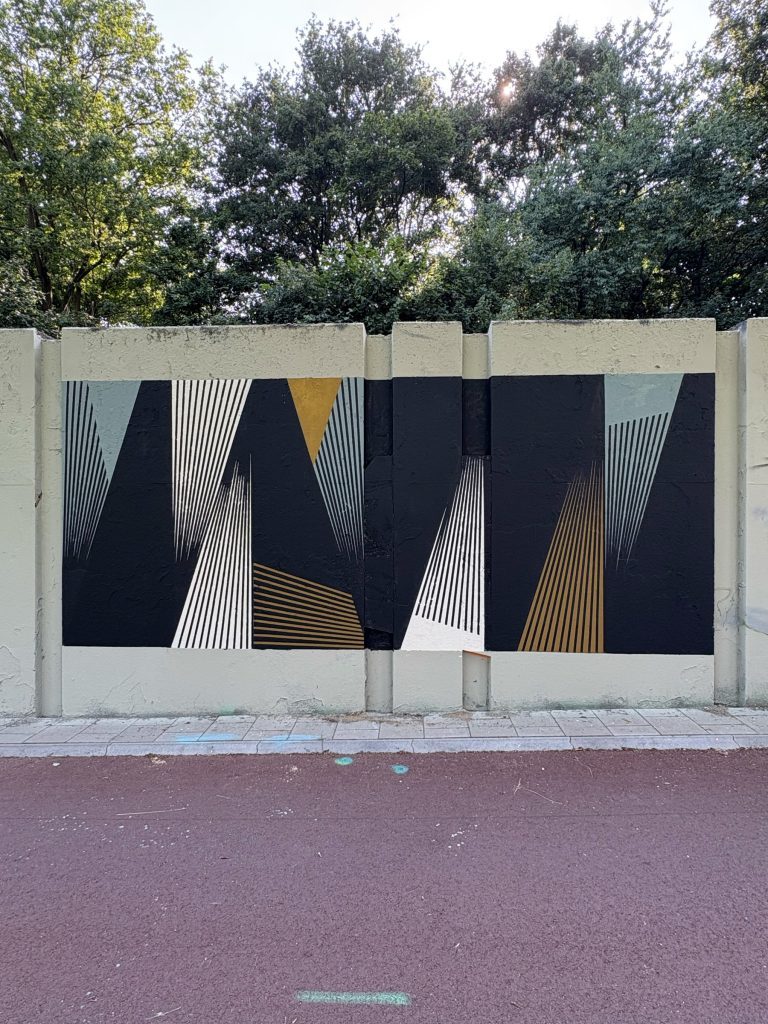
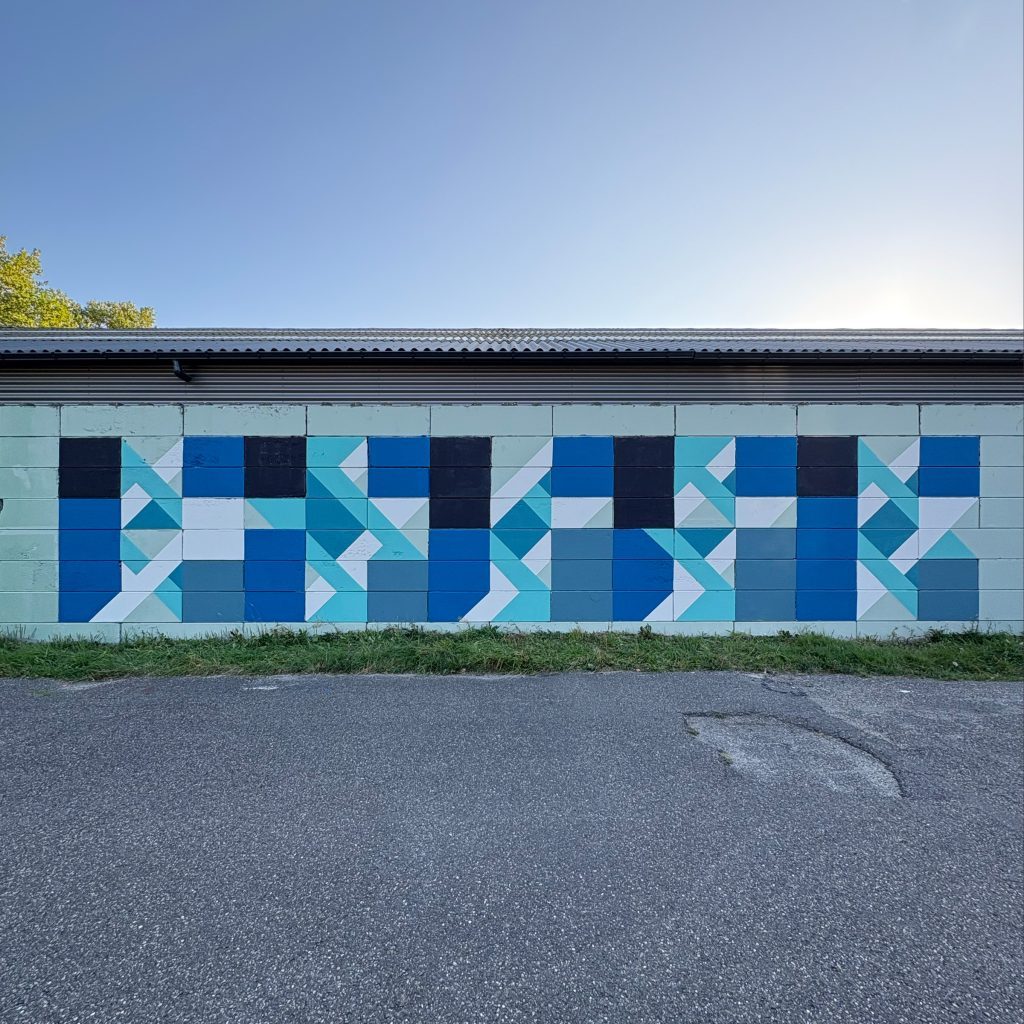
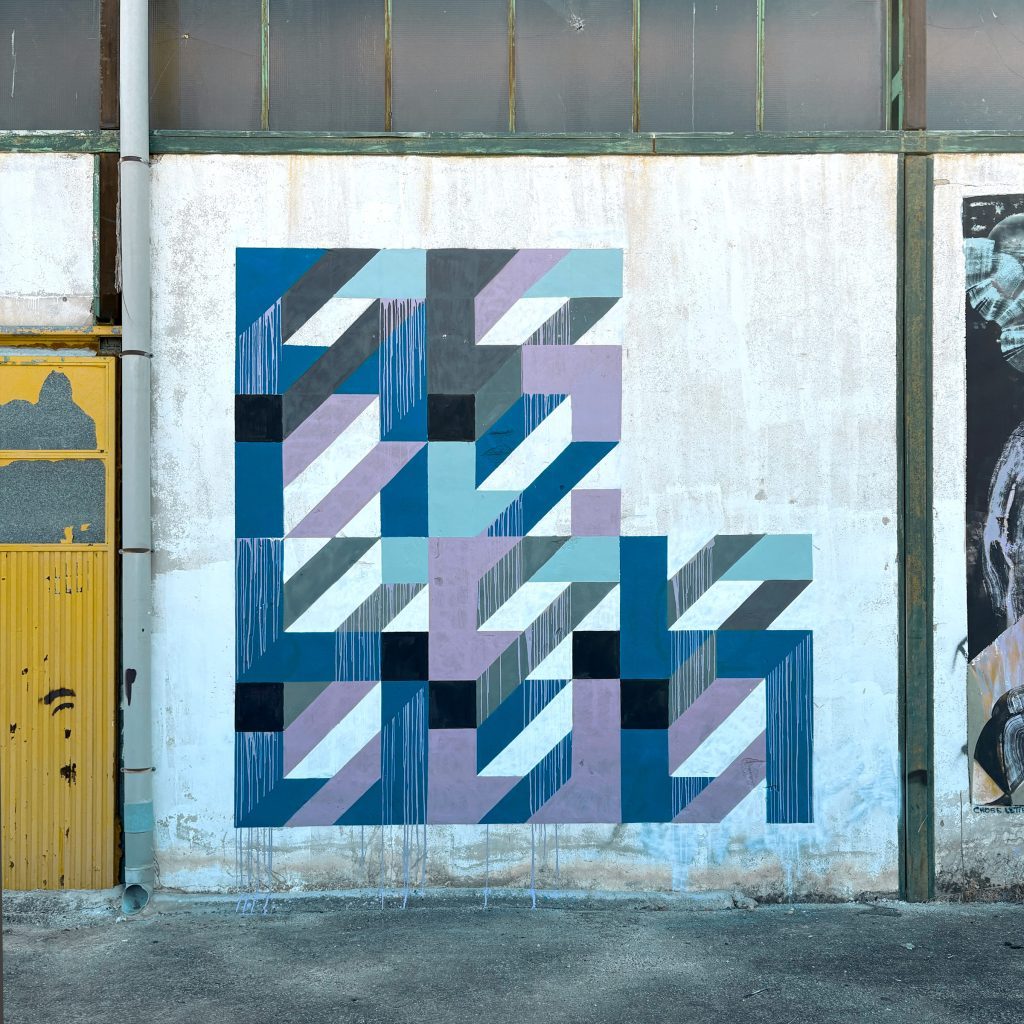

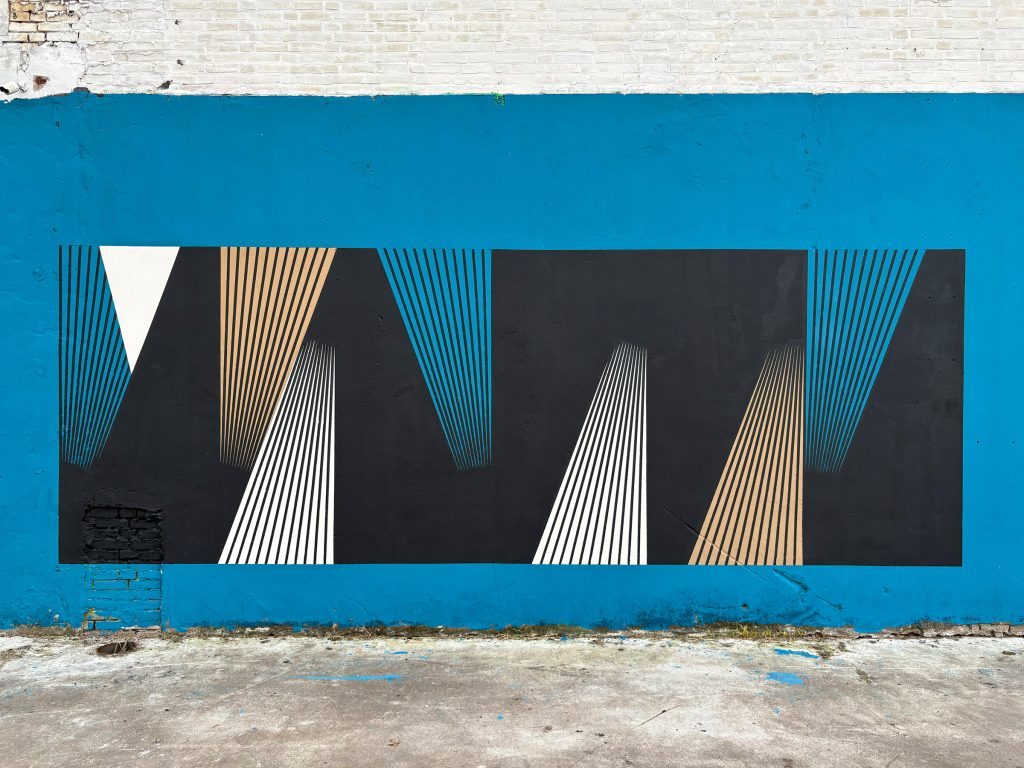
instagram.com/the_abstract_session
instagram.com/michadebie
instagram.com/eyes_b_tsunamigraffiti
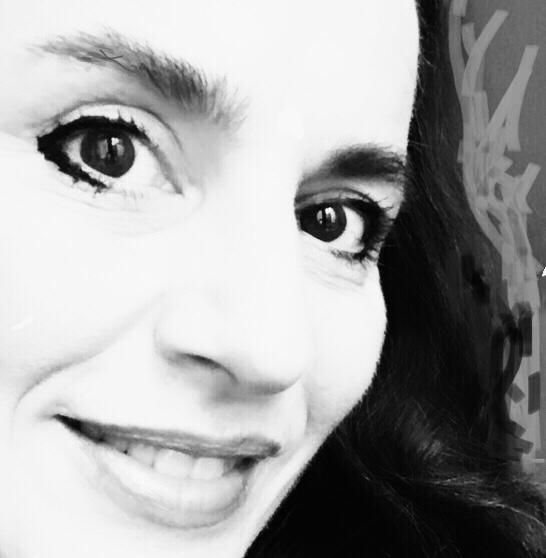
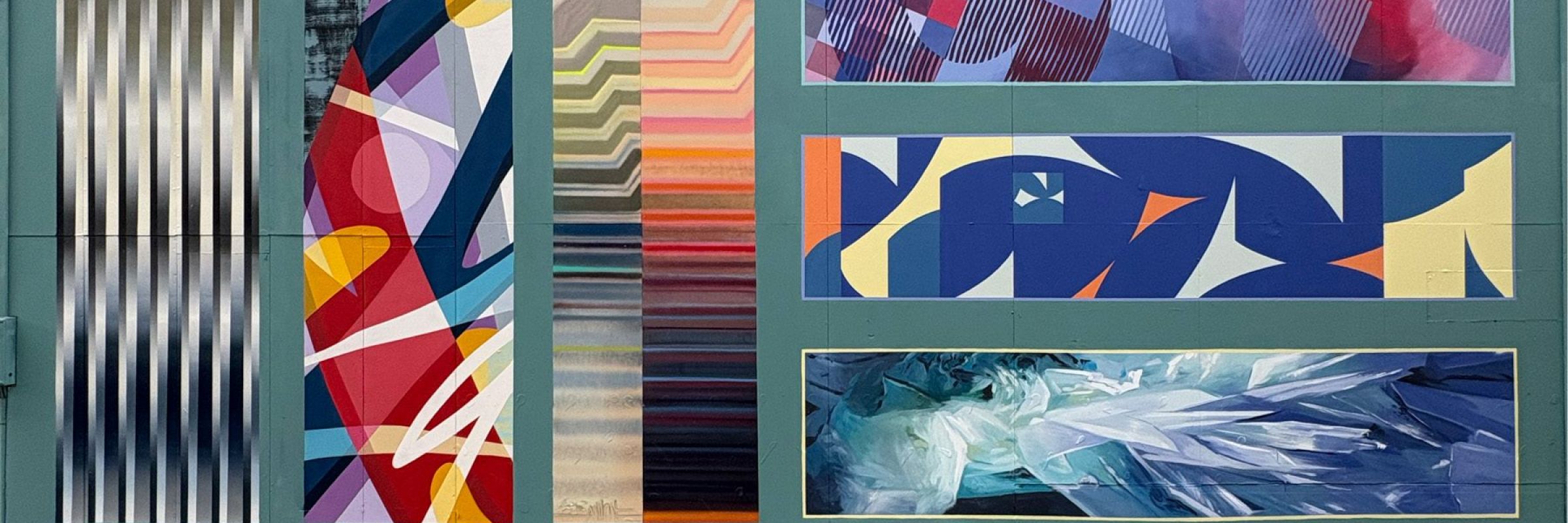
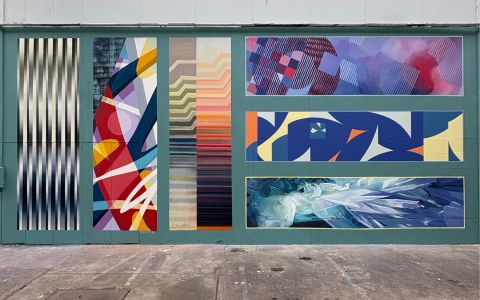
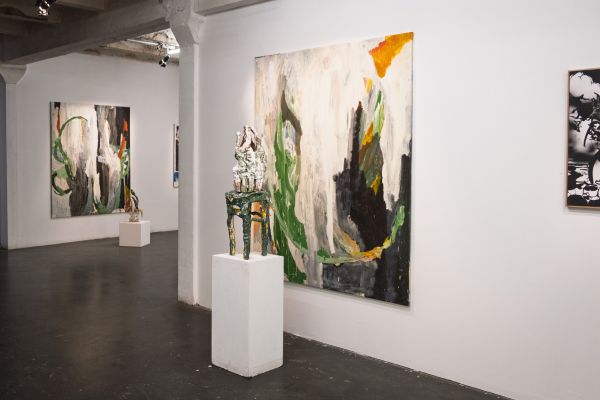
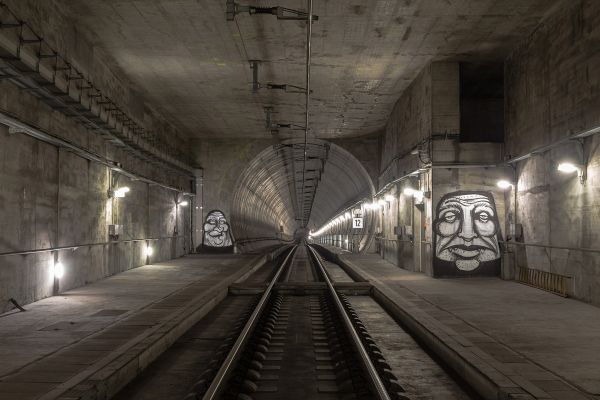

Leave a Reply